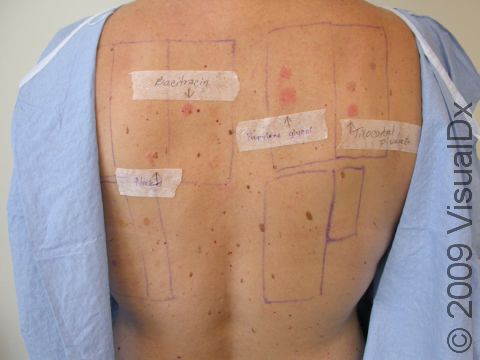Patch Test, Skin Allergies
Patch testing is a common outpatient procedure used by dermatologists and allergists to assess if a rash is caused by a suspected substance, known as an allergen, when it comes in contact with the patient’s skin. In addition to patch testing, a careful evaluation of the patient’s exposures in addition to the location and pattern of the rash on the body (clinical history) is necessary to determine the underlying allergen.
Who's At Risk?
Unexplained or persistently inflamed skin that is often itchy may be due to an allergic contact dermatitis caused by any of the following (to name a few):
- Use of prescription or non-prescription products applied to the skin, including topical ointments, creams, and lotions.
- Exposure to metals (eg, nickel, which can be found in jewelry, belts, buttons, etc)
- Chemicals such as paraphenylenediamine found in hair dye
- Fragrances found in perfumes and detergents
- Preservatives such thimerosal found in contact lens solution
- Rubber ingredients such as latex
Dermatitis can result if a patient’s skin is allergic or sensitive in any way to the substance it comes in contact with. A simple patch test guided by the clinical history can help determine if a substance is causing or aggravating the rash.
Signs & Symptoms
Before testing, to obtain the best results, patients should:
- Not use a topical steroid (eg, cortisone) cream on the back
- Not take oral steroids
- Discontinue any ultraviolet light (UVA or PUVA) treatment
- Not have a current rash on the back
The doctor performing the procedure will recommend the allergens that a patient’s skin will be tested for, which is usually a standard selection of common allergens that cause the majority of allergic skin reactions as well as any specific allergen that the patient’s skin may have come into contact with. Once the allergen selection is prepared using small plastic or aluminum discs, these are placed on the patient’s upper back in an area of skin unaffected by any current rash. Adhesive tape is used to secure the discs.
During the time that the allergen patches are in direct contact with the skin, the patient should avoid vigorous activity or washing the area until the final reading is done 96 hours later. Sun exposure should be avoided during this period of time. The skin test is examined 48 and 96 hours later, at which time the adhesive tape and discs are removed to assess for any response.
Self-Care Guidelines
When patch testing is completed, a record of the results is typically provided for the patient to explain which allergens to avoid and the products in which these allergens may be found. Avoiding the causative allergen in the future will likely completely eliminate or at least help improve the skin inflammation. Depending on the results, the doctor can determine if any of the allergens tested for are causing or worsening the dermatitis.
Patients may care for their skin with gentle soap and water, making sure to avoid the allergens identified in the results of the patch testing. The doctor may prescribe a topical steroid cream for the back to reduce the skin reaction caused by a positive patch test.
Treatments
Patch testing is normally required to confirm an allergic or irritant reaction to a suspected allergen. However, if the physician’s suspicion and the pattern of the inflammation on the skin (exposure pattern) support the association between an allergen and a patient’s dermatitis, simply avoiding the suspected allergen may suffice. For example, if a patient has a rash only on the earlobe and wrist, perhaps a nickel allergy may be considered due to the use of earrings and watches.
When to Seek Medical Care
An exaggerated allergic or irritant skin reaction may occur at the site of patch testing, including a rash and a burn-like reaction. It is important that an experienced physician in patch testing read the results to avoid potential misinterpretation. Patch testing may not always explain the cause of the dermatitis.
Last modified on October 5th, 2022 at 7:46 pm

Not sure what to look for?
Try our new Rash and Skin Condition Finder
